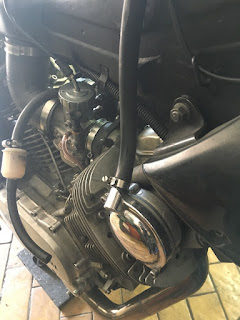Ok, so a couple of things have come up and will need tackling.
First and foremost: I have to move out of my current workshop, which is bit of a bummer, because by now I have quite well settled in. I've got a new place lined up, but its further away, so quick jaunts to fiddle with stuff will be more of a challenge. On the plus side, it's in the country side, which means there's quite a few roads, where I can do some testrides and not bother anyone. (Except maybe for some deer and the occasional rabbit or hare.)
Second: The TR1 engine needs rebuilding (again). The cylinders were rather worn to start and I thought I would be able to get away with it. Spoiler-alert: nope I don't. When ridden normally it's all nice and dandy in terms of oil-consumption (0.2 to 0.3L/1000km), but when flogged like the engine wants to on the Autobahn, she easily exceeds the 1L/1000km mark, actually more like double that figure.





Yes you saw right, I've got another BT1100 engine lined up and those internals will go into my own Everyday TR1 engine. Making me benefit from those Nikasil plated cylinders and lighter rotating assembly. Other than that, the basic recipe with XV700 heads and decreased squish gap will stay pretty much the same. It should be an interesting build nonetheless, even though probably more for me, as it's all about those little differences. In the course of this, I will also have a look at the gearbox, because even though it works just fine, when I had the clutch out, it showed a lot of sideplay on the input shaft, so I might find some drama there as well. Also I plan to fit some springs to hold the muffler-elbows in place.
Third: The Dre-XT-Stück will receive a super-rare* Austrian XT600 43F frame and I will build a 600 engine for it. I have, somewhat by accident, acquired a XT600 Tenere 1VJ (the one from the engine build) and after testriding it back to back with the Dre-XT-Stück building a 600 engine has become imperative. (No, I can't just fit the 1VJ engine into the new Dre-XT-Stück frame as the 1VJ is a an electric-start engine and they are wider...) Now in Austria back in the day, there were only two tax and insurance classes: up to 500cc and from 500cc to infinity. This basically meant, if you bought a 600cc bike, you paid the same amount of taxes as you would on a 1000cc or 1500cc bike, which meant if you weren't a complete nutter and absolutely wanted such a bike, you would have bought a tax-saving version like the Dre-XT-Stück currently is. (This is meant to illustrate, why Austria has had some quirky small-bore versions of various dirtbikes, e.g. XT600s, DR600 and also why the KTM LC4 started out as a 500 overhere.)
Fourth: Quite simply put, I owe my dad some help on his CX500 and his other bikes to get them up to a decent standard so he can enjoy them a lot more next year than he did this season. Ironically tackling the CX500 will be one of the first of the Winter projects to tackle as really it is mostly about getting the carbs done and then work out, why it is draining the battery when parked and fitting some rear indicators and a couple of other small jobs all around the bike. All in all, maybe two days of work on the bike and she should be ready to go on the road.







































